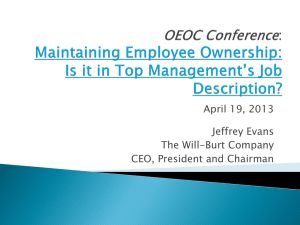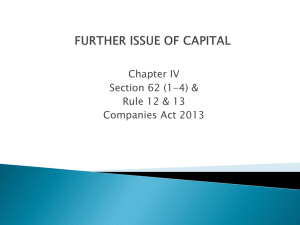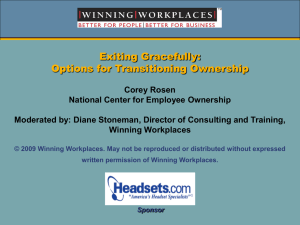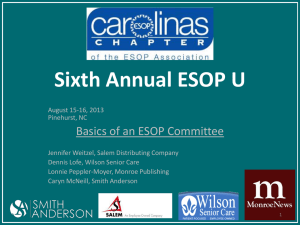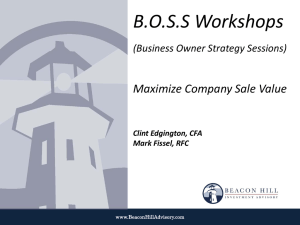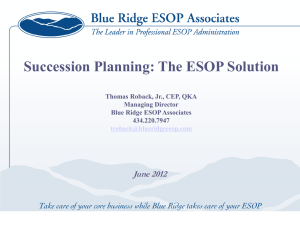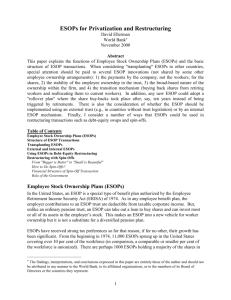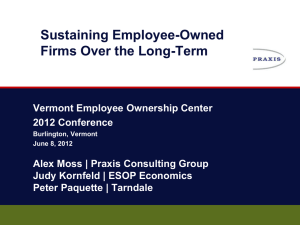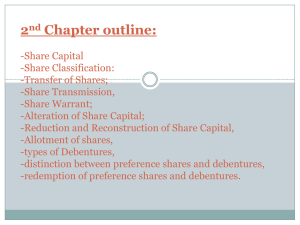associated cash requirements
advertisement
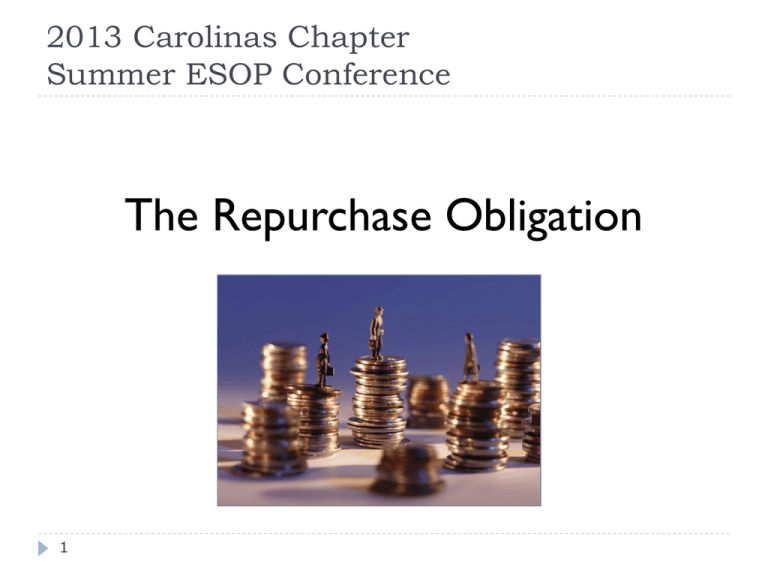
2013 Carolinas Chapter Summer ESOP Conference The Repurchase Obligation 1 ESOP Repurchase Obligation Represents a closely held company’s obligation to buy back shares of stock from ESOP participants Future Distribution Funding “Put option” may entitle participants to have shares distributed and then purchased by the company at fair market value ESOP document may provide that participants receive cash from the Plan for their shares (S corporation, or C-corporation with bylaw restrictions) Future Diversification Funding Diversification participation 2 rights begin at age 55 with 10 years of plan Repurchase Obligation Study A repurchase obligation study is a long-term projection of ESOP distributions and the associated cash requirements that a company will face AND An analysis of strategies for managing and funding the resulting obligations 3 When Should a Study Be Done? Feasibility /Initial Design Stages Lender may require it Assess impact of expected cash flows to plan sponsor Modeling can be used as a tool for ESOP plan design Ongoing Assessment –no hard and fast rule on how often a study should be updated 4 When reality diverges from recent assumptions ESOP is considering a new transaction When there is a need to assess changes in distribution policies or funding strategies Otherwise, generally every 2-3 years What Impacts Repurchase Obligation? Employee demographics, age profile Employee turnover rates and patterns Death, disability Changes in size of workforce Salary increases, compensation of new hires Stock acquisition loan term; debt prepayments Share value/appreciation (depreciation) in value Distribution Policies and Practices Election rates - Diversification Plan design 5 Plan Design 6 Eligibility and entry provisions Allocation provisions Vesting schedule Definition of Retirement Age Plan distribution rules In-Service distributions, if any Diversification rules, including any early or expanded diversification features Account segregation WHO’S RESPONSIBILITY? 7 Who’s Responsibility? Corporate obligation to plan for and fund repurchase liability Code states that it is a corporate obligation 8 Where there are internal trustees, the lines of responsibility can get murky Possible for internal trustees to have a fiduciary responsibility for repurchase liability Who’s Responsibility? Trustee should take a proactive approach to repurchase liability 9 If funding the repurchase liability becomes an issue with the company, it will become an issue for the trustee Trustee should understand the nature of the liability and funding mechanism How does this affect the valuation? Who’s Responsibility? Company has responsibility to set distribution policy and plan provisions that govern distributions Distribution provisions 10 5 year wait and 5 year installment payout for terminees? Recycle vs. redeem (or combination) Segregate Diversification provisions Who’s Responsibility? Valuation Report 11 Should contain a section to explain/address repurchase liability and how it has been factored into the valuation report If a repurchase study has been conducted, the appraiser should review the study with the company or trustee to determine how repurchase will be factored into the valuation PAYING FOR REPURCHASE LIABILITY 12 How Is Repurchase Liability Paid? Sell the company Results in immediate liquidity for participant shares Redeem shares Company buys back shares and shares are retired to treasury account After-tax dollars that leave the company purchase shares Will not receive any further value allocation in the annual appraisal Recycling 13 Results in shares being recirculated in the ESOP Trust Redemption Will not have to repurchase these shares in the future Company can elect to re-contribute these shares or a portion of them to the plan May be a benefit to departing participants if NUA (net unrealized appreciation) exists Trustee should be concerned if other shareholders exist Reduces number of outstanding shares 14 Redemption Example Ex – 100% ESOP company is worth $5 mil with a $50/share value. There are 100,000 shs outstanding. Departing participants have 10,000 shs. So $500,000 leaves the company to repurchase shares from participants. Company is now worth $4,500,000. Company now has only 90,000 shs outstanding. $4,500,000/90,000 = $50/sh 15 Redemption Distribution Example OIA Balance Share Balance Share Value Participant John Doe $ 4,085.23 Jane Doe $ 675.38 Rosetta Stone $ 6,487.22 Total $ 11,247.83 10,000.00 $ 500,000.00 5,872.38 $ 293,619.00 Rollover $ 293,619.00 $ 4,104.23 $ 297,704.23 $ 675.38 $ 2,186.00 $ 103.10 4,083.90 $ 204,195.00 Direct Taxable $ 210,682.22 $ 42,136.44 $ 6,487.22 $ 204,195.00 $ - 43.72 $ 2,186.00 Direct Taxable $ Assumptions: Company redeems shares Stock distributed from the trust No state tax withholding involved Share price = $50 16 Distribution Gross Federal Available for Net Distribution Net Distribution Type Distribution Withholding Withholding from Company from ESOP Trust - 2,861.38 $ 572.28 $ $ 511,247.83 $ 500,000.00 Recycling 17 If other outside shareholders then won’t have to worry about losing ownership % Number of shares outstanding and ESOP % remains constant Will have to repurchase the same shares again in the future –over and over again Recycling Example Using same data from redemption example: 18 Ex – 100% ESOP company is worth $5 mil with a $50/share value. There are 100,000 shs outstanding. Departing participants have 10,000 shs. So $500,000 leaves the company and enters plan as a contribution. Company is now worth $4,500,000. Company still has 100,000 shs outstanding. $4,500,000/100,000 = $45/sh Segregation Results in recycling of shares within the plan 19 Repurchase is funded within the plan immediately Fiduciary liability for the investment of cash until time of distribution Shares within the plan are allocated to active participants currently contributing to the company FUNDING ALTERNATIVES 20 Sinking Fund - ESOP Advantages 21 Contributions and earnings are tax deductible Provides a mechanism for newer participants to get stock in their accounts Allows non-100% ESOP to maintain ownership percentage Cash not available to creditors Sinking Fund - ESOP Disadvantages 22 Cash accumulates inside the ESOP and cannot be used for corporate purposes Shares must be recycled May result in inactive participants accumulating more shares as their cash is being used to purchase shares of those currently eligible for distribution Sinking Fund - ESOP Other Considerations Not a $ for $ offset against repurchase as participants will accumulate OIA balances that will have to be paid May not be ideal where repurchases are lumpy or inconsistent from year to year Could result in larger than anticipated allocations in some years 23 Valuation Issues 24 Could result in reduced earnings and cash flow for valuation purposes Loss of flexibility as cash is no longer a corporate asset Is more cash than currently needed being set aside in the ESOP? Valuation Issues Growth rates considered in the ESOP valuation could be negatively impacted as cash is diverted to fund repurchase obligations versus investing in projects to grow the company Also, a potential negative impact on the cost of capital calculation = competing need of ESOP with company need to reinvest in the business Changing ability to honor the put right may also be reflected in a higher discount for lack of marketability 25 Sinking Fund - Company Advantages 26 Can contribute cash to plan as needed or use to redeem shares Retain flexibility to redeem or recycle shares Asset of the company so can still be used for corporate purposes if necessary Improves liquidity of the company Sinking Fund - Company Disadvantages 27 Cash is typically added to value on a $ for $ basis when valuing company stock which results in the value increasing (is this a disadvantage???) Contributions to the corporate sinking fund are not deductible Investment yields may be taxable This balance sheet asset isn’t protected from creditors in the event of bankruptcy Valuation Issues Cash is added to value on a $ for $ basis Balance sheet cash is available for growth 28 To the extent the cash is needed for repurchase, growth could be slowed Impact on cost of capital may be minimal Pay As You Go Advantages 29 Flexibility with cash to redeem or recycle Cash isn’t tied up in the plan or in a sinking fund on the balance sheet Can contribute a certain desired percentage of compensation to the plan each year Pay As You Go Disadvantages 30 Lack of planning for big events or unanticipated large payments Cash flow availability could be problematic if timing of distribution event and amount is unpredictable In the event of poor performance, the company may be restricted from putting cash in the ESOP Contributions must be within deduction limits Valuation Issues Similar to those listed before depending on whether shares are redeemed or recycled, i.e. – growth rates, cost of capital assumptions… Cash flows may be unpredictable 31 Difficult for the appraiser to predict the cash flows from year to year Use of normalized retirement plan benefit may be used to smooth the impact Other Funding Alternatives COLI – corporate owned life insurance Re-Leverage the ESOP External debt 32 Questions? Dolores Lawrence Blue Ridge ESOP Associates dlawrence@blueridgeesop.com Brant Armentrout ComStock Advisors barmentrout@comstockadvisors.com Dawn Goestenkors First Bankers Trust Services, Inc. Dawn.Goestenkors@FBTServices.com 33
